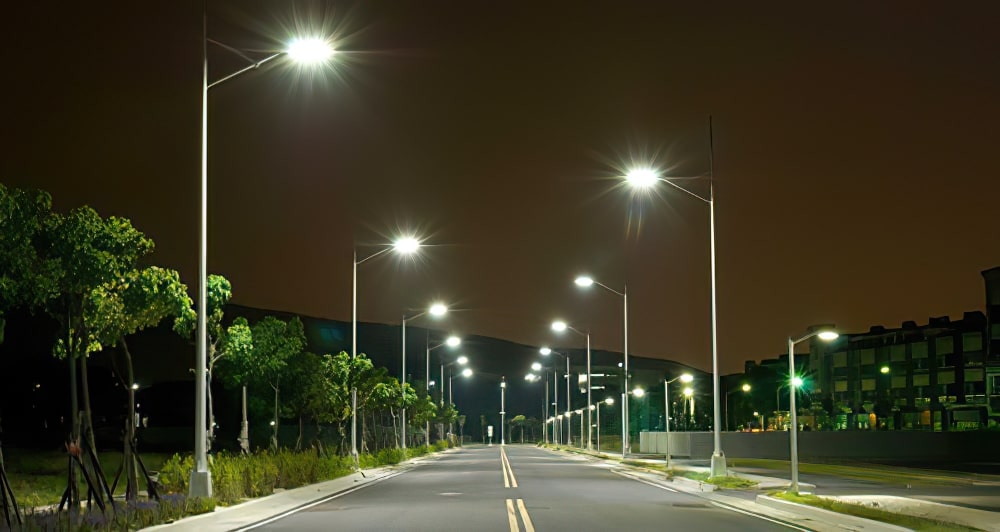Solar street lights usually require a battery to store and manage the energy harnessed from the sun. The inclusion of a battery in these systems plays a crucial role in ensuring a continuous and reliable power supply during periods of low sunlight. However, like any energy storage component, solar streetlight batteries are not immune to wear and tear. Do solar street light battery replacements occur frequently? Absolutely. It is perfectly acceptable to replace and responsibly dispose of your battery. Embracing this practice ensures optimal performance and longevity for your solar street lights. So, how common are these replacements, and what considerations should be taken into account when undertaking such a task? Let’s discover.

What warrants a solar street light battery replacement?
- Insufficient Capacity: If the battery’s capacity has significantly decreased, leading to inadequate energy storage and a reduced ability to power the solar street light efficiently.
- Diminished Performance: When the solar street light exhibits decreased brightness or fails to illuminate properly.
- Frequent Discharge Issues: If the battery frequently discharges too quickly or struggles to retain a charge.
- Visible Physical Damage: Any observable damage to the battery, such as leakage, swelling, or corrosion, warrants immediate attention.
- End of Lifecycle: Solar street light batteries have a limited lifespan, typically ranging from 3 to 10 years. If the battery has surpassed its expected lifespan, it is advisable to replace it proactively.
- Incompatibility with System: Changes or upgrades to the solar street light system that make the existing battery incompatible may require a replacement to ensure seamless integration and optimal performance.
- Inadequate Maintenance: Lack of proper maintenance, such as neglecting to clean the solar panels or failing to address issues promptly, can contribute to a battery’s deterioration and the need for replacement.
Assessing Current Battery Performance
The effective assessment of current battery performance stands as a critical endeavor. What should you consider when assessing your current battery?
A. Battery Age and Lifecycle:
Understanding the age and lifecycle of a battery is crucial for comprehending its overall performance. As batteries age, they undergo a series of chemical and physical changes that directly impact their ability to store and deliver energy efficiently. The lifecycle of a battery is characterized by its charge and discharge cycles, with each cycle contributing to the gradual deterioration of its internal components.
Scientifically, the aging process in batteries can be attributed to various factors, such as electrode material degradation, electrolyte breakdown, and the formation of solid-electrolyte interface (SEI) layers. These processes are influenced by temperature, depth of discharge, and charging rates. For instance, high temperatures accelerate chemical reactions, leading to a faster aging rate, while shallow discharge cycles can reduce stress on the battery, prolonging its overall lifespan.
B. Capacity Degradation Over Time:
Capacity degradation is a significant aspect of battery performance that directly impacts its ability to store energy. It involves the reduction in a battery’s ability to hold a charge over successive charge-discharge cycles. The scientific intricacies of capacity degradation include the progressive loss of active materials in electrodes, chemical changes in the electrolyte, and the growth of solid deposits that impede ion flow.
Detailed assessments involve analyzing the specific mechanisms behind capacity fade, such as the dissolution of electrode materials, the formation of dendrites, and the impact of side reactions. By delving into these scientific details, researchers can develop strategies to mitigate capacity degradation, thereby enhancing the longevity and efficiency of batteries.
C. Monitoring Charging and Discharging Cycles:
Monitoring charging and discharging cycles is imperative for optimizing battery performance. Scientifically, this involves tracking the flow of ions within the battery during each cycle. The Coulombic efficiency, which measures the ratio of discharged to charged electrons, is a critical parameter in this assessment. The efficiency is affected by factors like overcharging, undercharging, and the rate of charge and discharge.
Advanced monitoring techniques, such as in-situ electrochemical analysis and impedance spectroscopy, provide detailed insights into the electrochemical processes during cycles. This scientific approach enables a precise evaluation of the health of the battery, allowing for adjustments in charging protocols to maximize efficiency and minimize degradation. The charge and discharge cycles are crucial when considering a solar street light battery replacement.
D. Voltage Levels and Stability:
Voltage levels and stability are key indicators of a battery’s health and performance. Scientifically, monitoring the voltage during charge and discharge provides crucial information about the electrochemical reactions occurring within the battery. Fluctuations in voltage levels can signify issues such as electrode degradation, electrolyte breakdown, or internal resistance.
Detailed analysis involves examining voltage profiles, understanding the impact of temperature on voltage behavior, and evaluating the effects of high and low voltage on the overall battery system. Maintaining stable voltage levels is essential for ensuring the safe and efficient operation of batteries in various applications.
Types of Solar Street Light Batteries
What are some common types of batteries to consider when doing your solar street light battery replacement?
- Lithium-ion (Li-ion) Batteries: Lithium-ion batteries are widely used in solar street lights due to their high energy density, long cycle life, and lightweight design. They offer excellent performance and are known for their reliability. Li-ion batteries are suitable for areas with frequent power outages and can withstand extreme temperatures.
- Lead Acid Batteries: Lead acid batteries, both sealed lead acid (SLA) and flooded lead acid, have been traditionally used in solar applications. They are cost-effective but may have a shorter lifespan compared to lithium-ion batteries. Lead acid batteries are suitable for areas with stable climates and where cost is a significant consideration.
- Nickel-Cadmium (Ni-Cd) Batteries: Although less common today, Ni-Cd batteries were historically used in solar street lights. They are durable and can operate efficiently in a wide range of temperatures. However, they have a lower energy density compared to lithium-ion batteries, and environmental concerns related to cadmium have led to a decrease in their usage.
- Nickel-Metal Hydride (Ni-MH) Batteries: Ni-MH batteries are an alternative to Ni-Cd batteries and offer a more environmentally friendly option. They have a higher energy density and longer cycle life than Ni-Cd batteries. Ni-MH batteries are suitable for solar street lights in areas with moderate temperature variations.
- Solid-State Batteries: These batteries utilize solid electrolytes instead of liquid or gel electrolytes found in traditional batteries. Solid-state batteries offer several advantages, including higher energy density, increased safety, and longer cycle life. While still in the early stages of development for widespread commercial use, solid-state batteries hold promise for enhancing the efficiency and reliability of solar street lights in the future.
Solar street light battery replacement options
What are the critical considerations surrounding solar street light battery replacement?
A. Upgrading to Advanced Battery Technology: One key avenue for enhancing solar street light performance is the adoption of cutting-edge battery technologies. Lithium-ion batteries, for instance, present a compelling alternative to traditional lead-acid batteries. The inherent advantages of lithium-ion technology, including higher energy density, longer cycle life, and faster charging capabilities, contribute to improved overall system efficiency. Exploring such advancements in battery technology becomes imperative when contemplating solar street light battery replacement.
B. Compatibility with Existing Solar Street Light System: Ensuring seamless integration with the existing solar street light system is paramount when considering battery replacement options. The selected battery must align with the voltage and charging specifications of the system, preventing any operational discrepancies. Compatibility also extends to the physical dimensions of the battery, ensuring a snug fit within the designated space. Evaluating replacement options in light of system compatibility minimizes installation complexities and optimizes overall functionality.
C. Cost Considerations: Cost-effectiveness is a critical aspect of any solar street light battery replacement strategy. While advanced battery technologies may command a higher initial investment, a comprehensive cost analysis should consider factors beyond the upfront expenses. Factors such as maintenance costs, lifespan, and energy efficiency contribute significantly to the total cost of ownership. A judicious examination of these elements is essential for making informed decisions that align with budgetary constraints while maximizing long-term benefits.
D. Return on Investment Analysis: A rigorous ROI analysis is imperative to gauge the financial viability of solar street light battery replacement options. Calculating the payback period, factoring in energy savings, maintenance costs, and potential government incentives, provides a comprehensive understanding of the economic feasibility of the investment. This analysis aids decision-makers in determining the optimal balance between upfront costs and long-term gains, facilitating a strategic approach to solar street light battery replacement.
Installation and Integration after a solar street light battery replacement
After the careful selection of a suitable battery, the installation process demands precision and expertise. Engage certified technicians to facilitate the smooth transition from the old to the new battery. This active approach ensures that the upgraded energy storage system aligns seamlessly with the existing solar infrastructure. Active integration mandates a meticulous alignment with the solar street light system specifications. Verify that the replaced battery adheres to the voltage, capacity, and charging parameters outlined by the system. This active synchronization is vital to prevent operational discrepancies and ensures optimal performance.
Following the solar street light battery replacement, an active testing and commissioning phase is imperative. Conduct comprehensive functionality tests to validate the performance of the new battery within the solar street light system. Active monitoring during this phase allows for the identification and rectification of any potential issues, guaranteeing a flawless transition to enhanced energy storage capabilities.
An often overlooked yet crucial aspect of post solar street light battery replacement activities is user training and documentation. Actively engage yourself in training sessions and familiarize yourself with the upgraded battery system. Lastly, adopt an active stance towards ongoing maintenance and optimization. Implement a routine maintenance schedule to actively monitor and address any potential issues that may arise. Proactive maintenance not only ensures uninterrupted functionality but also contributes to the long-term optimization of the solar street light system.
Conclusion
A successful solar street light battery replacement hinges on a careful consideration of all the above crucial factors. Taking a proactive approach not only enhances the efficiency of the replacement process but also contributes to sustainable and reliable solar-powered street lighting solutions. Do you need a solar street light battery replacement expert? Contact us.


















